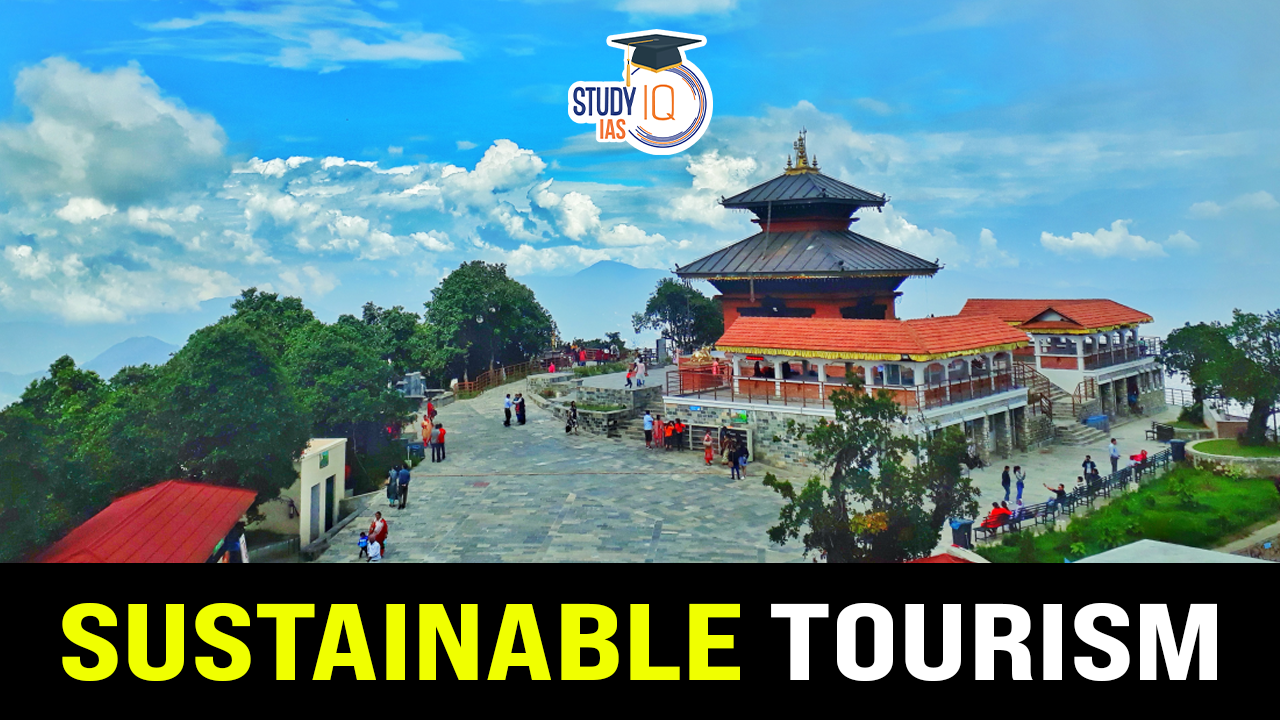Table of Contents
Context: The damage being caused to the Kashmir region’s fragile environment highlights the need for a resilient and sustainable tourism model.
What is Sustainable Tourism?
Sustainable tourism is defined by the UN World Tourism Organization as “tourism that takes full account of its current and future economic, social and environmental impacts addressing the needs of visitors, the industry, the environment and host communities.”
Components of Sustainable Tourism
- Make optimum utilisation of resources to support tourism development, maintain essential ecological processes and protect natural heritage and biodiversity.
- Honour the cultural authenticity of host communities, conserve their cultural and historical heritage, and promote intercultural understanding and tolerance.
- Ensure long-term economic viability, offering equitable socio-economic benefits to all stakeholders, including stable jobs, income opportunities, and social services for host communities aiding in poverty reduction.
Government Initiatives to Promote Sustainable Tourism
- National Strategy for Sustainable Tourism (NSST) with the following Pillars:
- Promoting Environmental Sustainability
- Protecting Biodiversity
- Promoting Economic Sustainability
- Promoting Socio-Cultural Sustainability
- Scheme for Certification of Sustainable Tourism
- IEC and Capacity Building
- Governance
- Designation of Indian Institute of Tourism & Travel Management (IITTM) as the Central Nodal Agency – Sustainable Tourism (CNA-ST) to assist the Ministry in the implementation of NSST
- Scheme of Domestic Promotion and Publicity including Hospitality: Under it Ministry of Tourism provides Central Financial Assistance (CFA) up to Rs.50.00 Lakh to State Governments and up to Rs.30 Lakhs to UT Administrations on the proposal of fairs/ festivals and tourism-related events such as seminars, conclaves, conventions
- SWADESH Darshan Scheme and PRASHAD scheme– provides financial assistance to State Governments/ Union Territory Administrations/Central Agencies for the development of tourism-related infrastructure and facilities
- Destination Based Capacity Building programme. It aims to train, upgrade, sensitise and to bring the services/training at the doorsteps of the local people and service providers residing near tourism sites and destinations who cannot afford to travel to the cities/towns to take training.
Issues related to unsustainable Tourism
- Waste Generation:
- Large Amounts of Waste Released into the Environment: Inadequate waste management systems are worsening pollution levels in water bodies, further compounding the ecological degradation.
- For Example- The Himalayan Clean Up (2022) waste audit revealed that 92.7% of the trash was plastic, and 72% of this plastic waste was non-recyclable.
- Misunderstanding Sustainability: Many in hospitality view sustainability as an additional cost rather than a long-term benefit overlooking opportunities for cost savings and reduced carbon footprints. This lack of understanding can lower sustainability ratings and hinder efforts to improve environmental, social, and governance (ESG) aspects of operations.
- Greenwashing:
- It involves ignoring the broader impacts of operations such as emissions from suppliers from a hotel claiming to be eco friendly
- Some businesses may misrepresent their operations as ecotourism to attract eco-conscious consumers.
- Effective certification and clear communication are essential to address and prevent greenwashing.
- High Consumption of water and energy
- Hotels use substantial energy for various operations, significantly raising their carbon footprint and impacting sustainability efforts
- According to an estimate in the hospitality industry, each guestroom wastes about 150 gallons of water daily
Impact of unsustainable tourism
- Unsustainable Pilgrimage Tourism: The promotion of pilgrimage tourism such as Mata Vaishno Devi Temple, Chardham Yatra Project has severely stressed the fragile ecosystem.
- Tourism influx exceeding the region’s carrying capacity leads to deforestation, waste accumulation and unregulated construction. Experts believe that it was unchecked tourism that was a key factor contributing to the catastrophic Jammu & Kashmir floods in 2014.
- Impact of Tourism-Driven Infrastructure Expansion on Natural Habitats: The surge in visitors necessitates expanding infrastructure such as hotels and roads which encroaches on natural habitats. This construction boom disrupts wildlife corridors, exacerbating soil erosion due to deforestation affecting the landscape.
- Strain on Local Resources due to Increased Demand for resources such as water & electricity:
- Excessive groundwater withdrawal depletes aquifers while increased electricity use leads to more hydroelectric projects which despite being renewable can harm aquatic ecosystems and disrupt hydrological balance.
- For Example Kashmir faces severe water shortages due to reasons such as rapid glacier depletion from climate change leading to reduced river flows and irrigation issues.
- Disrupting fragility of unexplored and pristine tourist destinations: Infrastructure development in unexplored tourist destinations where the intent is to boost accessibility and economic growth often ends up disrupting fragile ecosystems.
Examples of Unsustainable tourism in Fragile region:
- Jammu and Kashmir prone to earthquakes, floods, landslides and avalanches faced devastating floods in 2014 displacing thousands and causing economic losses amounting to ₹5,400-₹5,700 crore
- Flash floods near Amarnath in 2022 resulted in 16 deaths and 40 missing.
- The landslide in Wayanad Kerala which killed over 200 highlights the risks of unchecked commercialisation in ecologically sensitive areas.
Way Forward
- Adoption of a resilient and sustainable tourism model involving:
- Promotion of eco-friendly practices that minimise environmental degradation such as reducing waste, conserving water and protecting biodiversity.
- Inclusion of local communities in tourism planning and decision-making.
- Building Resilient Tourism requires infrastructure that can withstand extreme weather, diversifying tourism offerings beyond just the peak seasons and creating policies that protect the interests of both tourists and locals.
- Special tourist tax as recommended by TERI and Metroeconomica (2013). It is collecting a modest tax in the form of a service fee for the provision of high-quality environmental services to visitors.


 Serious Fraud Investigation Office (SFIO...
Serious Fraud Investigation Office (SFIO...
 Article 142 of Indian Constitution, Sign...
Article 142 of Indian Constitution, Sign...
 Pakistan-Occupied Kashmir (PoK): History...
Pakistan-Occupied Kashmir (PoK): History...





















